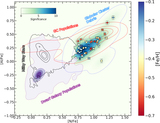APOGEE-2 Discovery of a Large Population of Relatively High-metallicity Globular Cluster Debris
Abstract
We report the discovery of a new, chemically distinct population of relatively high-metallicity ([Fe/H] > -0.7) red giant stars with super-solar [N/Fe] (≳+0.75) identified within the bulge, disk, and halo of the Milky Way. This sample of stars was observed during the second phase of the Apache Point Observatory Galactic Evolution Experiment (APOGEE-2); the spectra of these stars are part of the seventeenth Data Release (DR 17) of the Sloan Digital Sky Survey. We hypothesize that this newly identified population was formed in a variety of progenitors, and is likely made up of either fully or partially destroyed metal-rich globular clusters, which we refer to as globular cluster debris (GCD), identified by their unusual photospheric nitrogen abundances. It is likely that some of the GCD stars were probable members of the Gaia-Enceladus-Sausage accretion event, along with clusters formed in situ.
- Publication:
-
The Astrophysical Journal
- Pub Date:
- September 2021
- DOI:
- 10.3847/2041-8213/ac225b
- arXiv:
- arXiv:2109.02669
- Bibcode:
- 2021ApJ...918L..37F
- Keywords:
-
- Stellar abundances;
- Red giant stars;
- Globular star clusters;
- 1577;
- 1372;
- 656;
- Astrophysics - Astrophysics of Galaxies
- E-Print:
- 9 pages, 4 figures, 1 table, accepted for publication in The Astrophysical Journal Letters
